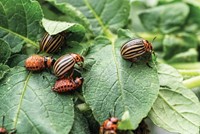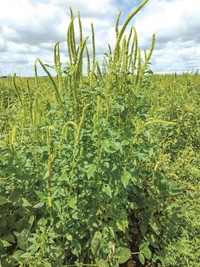Advertisement
Grab your lab coat. Let's get started
Welcome!
Welcome!
Create an account below to get 6 C&EN articles per month, receive newsletters and more - all free.
It seems this is your first time logging in online. Please enter the following information to continue.
As an ACS member you automatically get access to this site. All we need is few more details to create your reading experience.
Not you? Sign in with a different account.
Not you? Sign in with a different account.
ERROR 1
ERROR 1
ERROR 2
ERROR 2
ERROR 2
ERROR 2
ERROR 2
Password and Confirm password must match.
If you have an ACS member number, please enter it here so we can link this account to your membership. (optional)
ERROR 2
ACS values your privacy. By submitting your information, you are gaining access to C&EN and subscribing to our weekly newsletter. We use the information you provide to make your reading experience better, and we will never sell your data to third party members.
Agriculture
Betting on RNAi as the new wave of crop protection solutions
Scientists see the Colorado potato beetle as a test case for the new technology
by Emily Harwitz
November 28, 2021
| A version of this story appeared in
Volume 99, Issue 43

The spotted bronze head and shiny black-and-yellow-striped wings of the Colorado potato beetle are an unwelcome sight for farmers. Though larvae and adults feed primarily on potato plants, the Colorado potato beetle also eats other plants in the Solanaceae family, otherwise known as the nightshades, famed for the potent alkaloid content in their leaves.
To cope with eating the toxic leaves of these plants, the beetle has evolved mechanisms to metabolize toxins, including chemical pesticides. This ability has helped it become the world’s biggest potato pest since spreading from the Southwest US in the 1850s.
Russ Groves, a professor and extension specialist in the University of Wisconsin–Madison’s Entomology Department, has been studying insecticide resistance in agricultural systems for decades and says the potato growers he works with are all too familiar with the beetle’s special ability. “So if your question is, ‘Do Colorado potato beetles generate resistance?’ ” he says, the answer is, “Oh my God, yes.”
To overcome insecticide resistance, some in the agriculture industry are now betting on a new class of chemicals called RNA interference (RNAi) pesticides. One of the companies working on them is GreenLight Biosciences, which is poised to go public in the next few months in a deal that could value it at $1.2 billion. Scientists have been working on RNAi pesticides for over a decade. Many in the industry think the pesticides are now ready to move agriculture to a kind of crop protection that is more effective and less harmful to the environment.
Some sources say the first successful application of an agrochemical occurred in the 1860s when farmers managed to kill the potato beetleby spraying Paris green, or cuprous acetoarsenite, onto their fields. But the beetle is legendary for its ability to develop resistance to insecticides. That includes more modern chemicals such as the neonicotinoid imidacloprid, which has been making news for its devastating impact on pollinators.
Mechanical methods, like plowing a deep trench between last season’s potato crop and the new one, can thwart the potato beetle. When the beetle larvae emerge in the spring from the old field, some of them will fall into the trench and get trapped. Growers can also flame their fields using propane-powered jets of fire that heat the plants up hot enough to annihilate beetles without killing the more heat-resistant potato plants. But these methods can be inefficient and don’t easily scale up.
The beauty of RNAi, proponents say, is that it’s very specific and less likely to harm other insects, plants, and animals than conventional broad-spectrum pesticides are. It also leaves little environmental impact since RNA degrades easily.
RNAi technology is based on an evolutionary response to viruses. In living organisms, single-stranded messenger RNA (mRNA) translates genetic code into proteins. Viruses have double-stranded RNA (dsRNA) that they inject into host cells to replicate, a process which includes making mRNA. When a cell encounters the dsRNA of a virus, the cell initiates a defense by chopping it up into tiny pieces. Other organelles in the cell then search for any strands of mRNA that match the pieces of dsRNA and chop them up as well, thus preventing viral proteins from being made.
Around 2006, when the discovery of the process won two scientists the Nobel Prize in Physiology or Medicine, researchers began working on ways to harness this natural response to target pathogens or pests. They figured that introducing the right dsRNA into a target pest would cause the pest to chop up its own mRNA. The sequence must be unique to that pest and code for a protein that’s necessary for the organism’s survival. The most common formulation being developed is a dsRNA-containing spray meant to coat the leaves of plants the pest is going to ingest.
Determining which unique nucleotide sequence to encode in the dsRNA is “something that can be done partially bioinformatically” by comparing the genomes of the insect with other organisms in the same ecosystem, says Marko Petek, who researches transcriptomics, or gene expression, at the National Institute of Biology in Slovenia. The next step is testing the dsRNA in the lab to see how the pest processes it after ingestion, Petek explains, and to ensure that no nontarget organisms are affected.

Colorado potato beetles are especially sensitive to RNAi largely because their guts lack the nucleases that other insects have to degrade dsRNA after ingesting it. Petek has observed the susceptibility in his own research with the bugs. Researchers have already shown that potato beetles can eventually develop resistance to RNAi, so Petek says RNAi pesticides should be used in concert with other pest management tools to minimize—or at least delay—the risk of resistance happening.
“When I started looking at [RNAi pesticides] in 2007, it was just a niche thing,” Petek says. Since then, he says, the cost of manufacturing RNA has plummeted, in part because of the funding that poured into making mRNA for COVID-19 vaccines.
GreenLight says producing RNA economically is one of its strengths, and it claims that its RNA factory in Rochester, New York, is the world’s biggest. Among the agricultural products the company is developing are pesticides targeting the Colorado potato beetle; the varroa mite, which is a destructive honeybee parasite; and a powdery mildew that blights soft fruits like grapes and strawberries.
GreenLight has submitted the potato beetle pesticide to the US Environmental Protection Agency for approval. Mark Singleton, GreenLight’s head of plant health innovations, says the company has been testing the product in the field for 4 years, and in that time, it has controlled the potato beetle as effectively as “the best chemistry that growers can buy. Not only that, but we also know from those same trials that when we’ve measured the other insects in the field, we’re not having a negative impact.”
To find the target RNA sequence, GreenLight relies first on the expertise of the company’s scientists to identify a gene and then on machine learning to generate feedback on that specific target. “It is a combination of expertise, knowledge, and experience coupled with some pretty sophisticated and pretty cool algorithms that really allow the machines to do a lot of the heavy lifting,” Singleton says.
After the pesticide for the potato beetle is perfected, modifying it for different pests will be a simple tweak in the manufacturing process, once a specific RNA sequence has been identified, and easy for a farmer to switch out in a sprayer, GreenLight says. Traditional chemical pesticides, in contrast, can take over a decade and many millions of dollars to develop.
Subba Reddy Palli, a professor of entomology at the University of Kentucky, has also researched and developed RNAi pesticides and works with GreenLight. A major benefit of RNAi pesticides is that they are species specific, “with precision like a bullet,” Palli says. “So far as we know, based on what we have done in the lab, there is no reason to believe that these double-stranded RNAs would cause problems in other organisms.”
dsRNA degrades rapidly in the environment, so formulating products is tricky. The pesticide spray must stay on the leaves of the plants long enough for the target insect to eat them. “We want to be cautious about hyping the technology until we have a good delivery method to get this into the field,” Palli says.
But from an environmental perspective, dsRNA’s instability in the environment is one of its key benefits. When dsRNA gets into the field, soil microbes easily break down the organic molecules into “tinier and tinier fragments of RNA,” says Jonathan Willow, who researches RNAi at the Estonian University of Life Sciences. On the other hand, not only are conventional insecticides toxic to many creatures that encounter them, but “there are residues of pesticides in the bodies of insects that consume them, and that can have an effect on the upper levels [of predators] that eat those,” Willow says.
“To me, it’s organic agriculture, as much as it could be as an insecticide,” Willow says of RNAi pesticides. But, he cautions, these very targeted pesticides should be used in consideration with impacts to pests’ natural predators.
That said, Willow is excited for RNAi pesticides to be added to the crop protection toolbox. He describes GreenLight’s recent field trial as “awesome” and says he has no doubt the firm will succeed, because its main target pests, like the Colorado potato beetle, are highly sensitive to dsRNA. “There’s an obvious reason why the companies are focusing on these right now.”
Another firm working on RNAi pesticides is Saint Louis–based RNAissance, which is field-testing a dsRNA pesticide targeting diamondback moths.
“People have been trying to crack this RNA for pest control problem for a long time,” says Candace Seeve, director of laboratory operations for TechAccel, RNAissance’s parent company. The difference now, Seeve says, is that companies like RNAissance have identified how to produce RNA at low cost. RNAissance uses large-scale fermentation, which is already widely used in other industries, Seeve says.
With the excitement around RNAi come some unknowns. “The promotion of these new technologies comes from industry, where there’s clear support for the technology itself, but there’s not a lot of funding to look at the environmental risk part of it,” says Yolanda Chen, associate professor in the Department of Plant and Soil Science at the University of Vermont. Chen researches the ecology and evolution of insects as pests in agricultural ecosystems.
“RNAi is really interesting because it’s so simple and can be really specific too,” Chen says. “I think there’s a lot of promise but also a lot of need for trying to understand nontarget impacts as well.”
Groves, the Wisconsin researcher, says the potato growers he works with are excited about RNAi. “These days,” he says, “folks will absolutely respond to whatever is the most biologically based program they can implement.”
CORRECTION
This story was updated on Dec. 2, 2021, to remove the word "fermentation" from descriptions of GreenLight Biosciences' production process. The firm does use fermentation to make enzymes and plasmid, but its main production process occurs outside a living cell and is not considered fermentation.
CORRECTION
The story was updated on Dec. 8, 2021, to remove statements that RNA degrades into amino acids. RNA contains no amino acids.





Join the conversation
Contact the reporter
Submit a Letter to the Editor for publication
Engage with us on Twitter